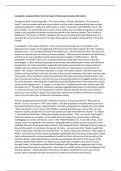Exam (elaborations)
Corruption and greed often lie at the heart of American Literature considering The Grapes of Wrath and The Great Gatsby
- Course
- Institution
A-Level English Literature OCR essay. Corruption and greed often lie at the heart of American Literature considering The Grapes of Wrath and The Great Gatsby. Achieved 27/30 which would like be an A*/A. Includes context
[Show more]



